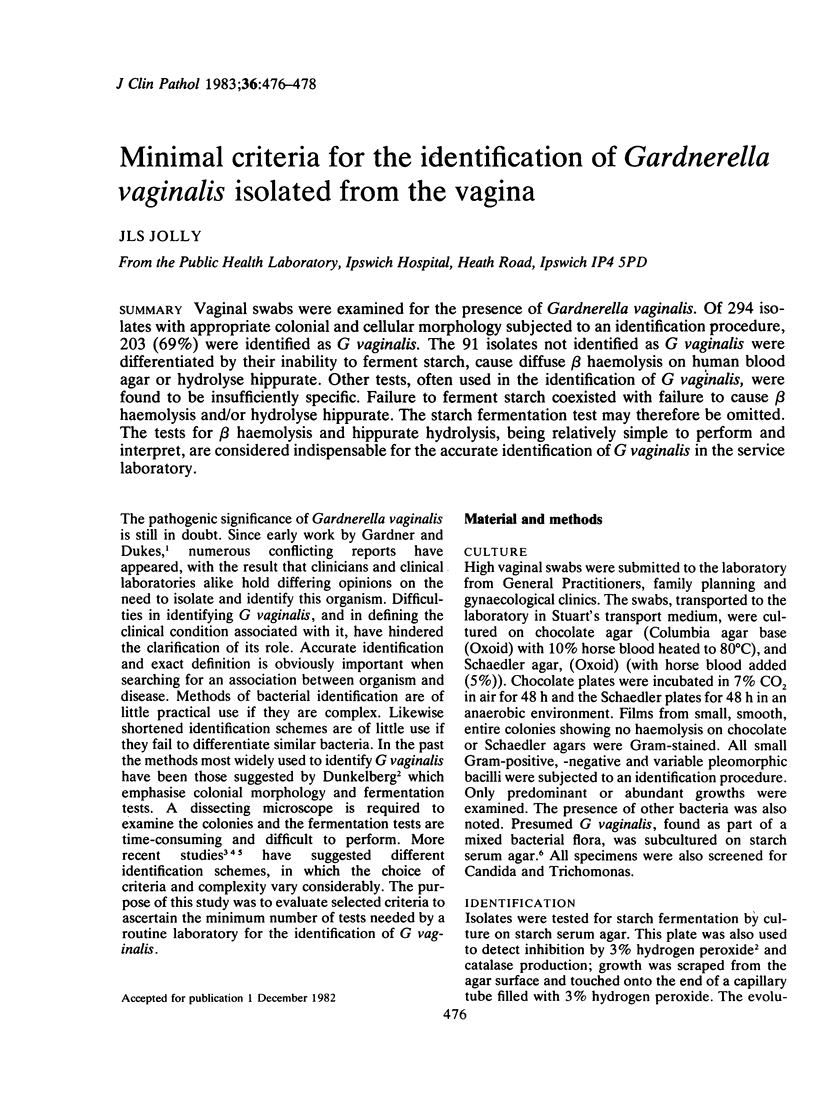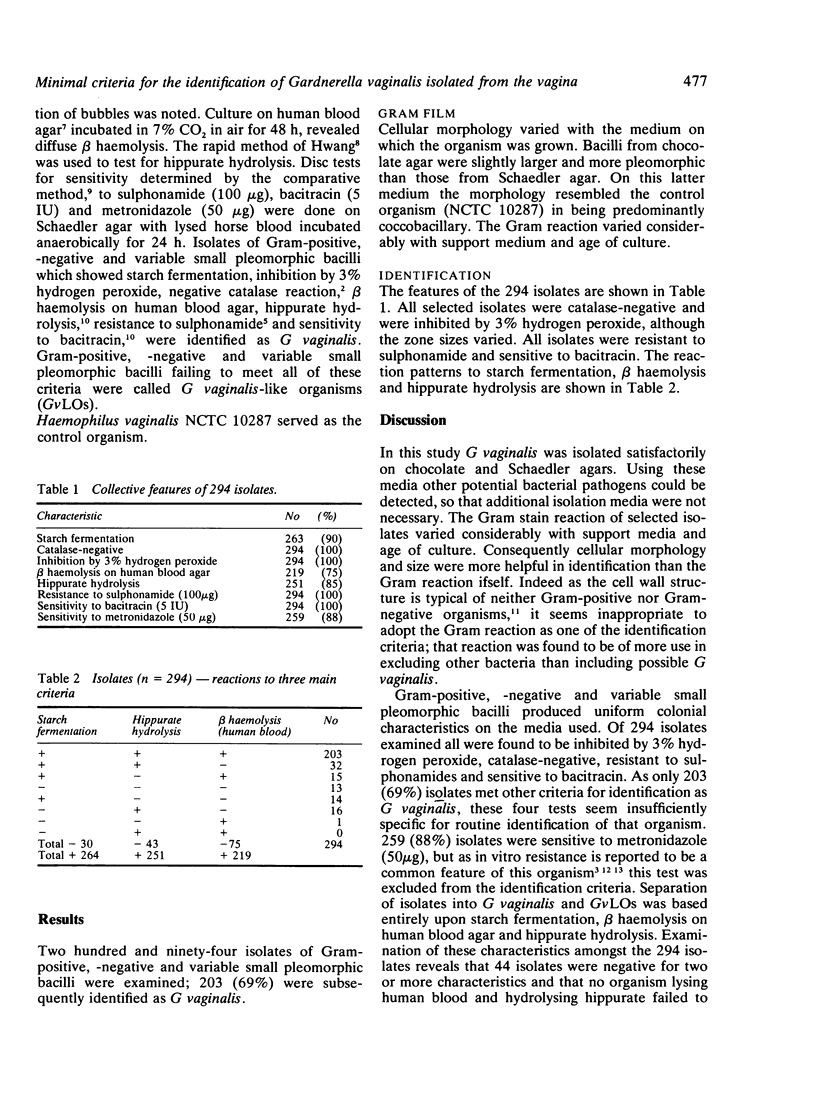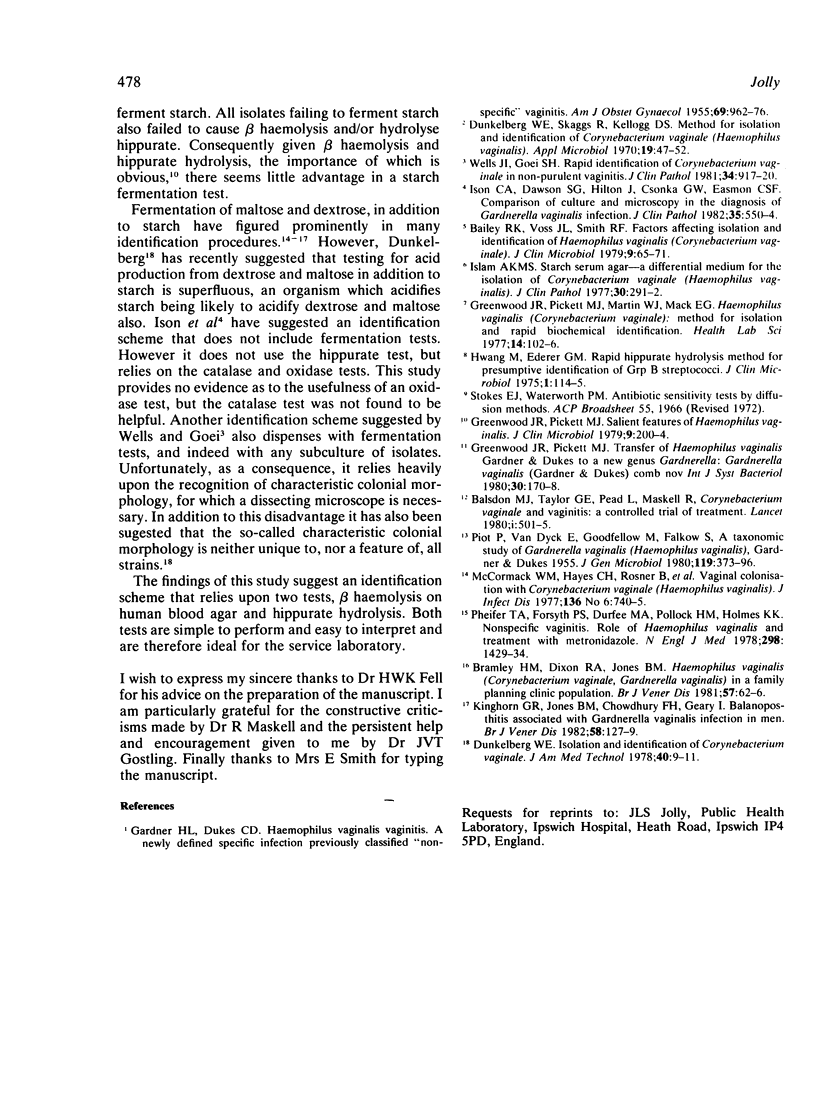Abstract
Vaginal swabs were examined for the presence of Gardnerella vaginalis. Of 294 isolates with appropriate colonial and cellular morphology subjected to an identification procedure, 203 (69%) were identified as G vaginalis. The 91 isolates not identified as G vaginalis were differentiated by their inability to ferment starch, cause diffuse beta haemolysis on human blood agar or hydrolyse hippurate. Other tests, often used in the identification of G vaginalis, were found to be insufficiently specific. Failure to ferment starch coexisted with failure to cause beta haemolysis and/or hydrolyse hippurate. The starch fermentation test may therefore be omitted. The tests for beta haemolysis and hippurate hydrolysis, being relatively simple to perform and interpret, are considered indispensable for the accurate identification of G vaginalis in the service laboratory.
Full text
PDF


Selected References
These references are in PubMed. This may not be the complete list of references from this article.
- Bailey R. K., Voss J. L., Smith R. F. Factors affecting isolation and identification of Haemophilus vaginalis (Corynebacterium vaginale). J Clin Microbiol. 1979 Jan;9(1):65–71. doi: 10.1128/jcm.9.1.65-71.1979. [DOI] [PMC free article] [PubMed] [Google Scholar]
- Balsdon M. J., Taylor G. E., Pead L., Maskell R. Corynebacterium vaginale and vaginitis: a controlled trial of treatment. Lancet. 1980 Mar 8;1(8167):501–503. doi: 10.1016/s0140-6736(80)92762-2. [DOI] [PubMed] [Google Scholar]
- Bramley H. M., Dixon R. A., Jones B. M. Haemophilus vaginalis (Corynebacterium vaginale, Gardnerella vaginalis) in a family planning clinic population. Br J Vener Dis. 1981 Feb;57(1):62–66. doi: 10.1136/sti.57.1.62. [DOI] [PMC free article] [PubMed] [Google Scholar]
- GARDNER H. L., DUKES C. D. Haemophilus vaginalis vaginitis: a newly defined specific infection previously classified non-specific vaginitis. Am J Obstet Gynecol. 1955 May;69(5):962–976. [PubMed] [Google Scholar]
- Greenwood J. R., Pickett M. J., Martin W. J., Mack E. G. Heamophilus vaginalis (Corynebacterium vaginal): method for isolation and rapid biochemical identification. Health Lab Sci. 1977 Apr;14(2):102–106. [PubMed] [Google Scholar]
- Greenwood J. R., Pickett M. J. Salient features of Haemophilus vaginalis. J Clin Microbiol. 1979 Feb;9(2):200–204. doi: 10.1128/jcm.9.2.200-204.1979. [DOI] [PMC free article] [PubMed] [Google Scholar]
- Hwang M. N., Ederer G. M. Rapid hippurate hydrolysis method for presumptive identification of group B streptococci. J Clin Microbiol. 1975 Jan;1(1):114–115. doi: 10.1128/jcm.1.1.114-115.1975. [DOI] [PMC free article] [PubMed] [Google Scholar]
- Kinghorn G. R., Jones B. M., Chowdhury F. H., Geary I. Balanoposthitis associated with Gardnerella vaginalis infection in men. Br J Vener Dis. 1982 Apr;58(2):127–129. doi: 10.1136/sti.58.2.127. [DOI] [PMC free article] [PubMed] [Google Scholar]
- McCormack W. M., Hayes C. H., Rosner B., Evrard J. R., Crockett V. A., Alpert S., Zinner S. H. Vaginal colonization with Corynebacterium vaginale (Haemophilus vaginalis). J Infect Dis. 1977 Dec;136(6):740–745. doi: 10.1093/infdis/136.6.740. [DOI] [PubMed] [Google Scholar]
- Pheifer T. A., Forsyth P. S., Durfee M. A., Pollock H. M., Holmes K. K. Nonspecific vaginitis: role of Haemophilus vaginalis and treatment with metronidazole. N Engl J Med. 1978 Jun 29;298(26):1429–1434. doi: 10.1056/NEJM197806292982601. [DOI] [PubMed] [Google Scholar]
- Piot P., van Dyck E., Goodfellow M., Falkow S. A taxonomic study of Gardnerella vaginalis (Haemophilus vaginalis) Gardner and Dukes 1955. J Gen Microbiol. 1980 Aug;119(2):373–396. doi: 10.1099/00221287-119-2-373. [DOI] [PubMed] [Google Scholar]


